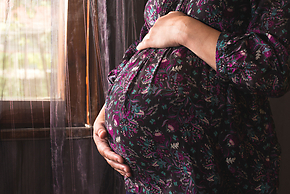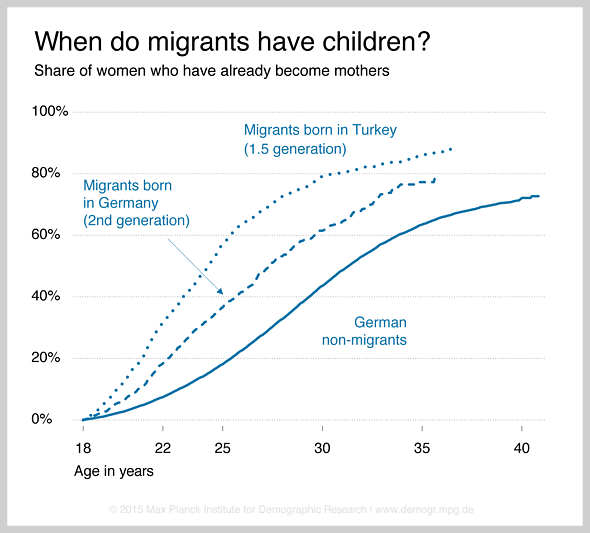September 24, 2015 | Press Release
Culture during childhood shapes family planning
New study on migration and fertility: Women born in Turkey become mothers earlier and more often after migrating to Germany than women born in Germany to Turkish parents.

Women born in Turkey become mothers earlier and more often after migrating to Germany than women born in Germany to Turkish parents. © deyangeorgiev / photocase.com
Rostock, Germany. The number of children we have and at what age is not just a conscious decision made as an adult . Apparently young parents are noticeably impressed by childhood experiences, as a new analysis on Turkish migrant data by the Max Planck Institute for Demographic Research (MPIDR) in Rostock, Germany, proves. Women born in Turkey who moved to Germany after entering school became mothers more often and at younger age than women who were born to Turkish parents in Germany. Both groups have children earlier and more frequently than Western German non-migrants.
These findings have now been published by MPIDR researcher Katharina Wolf together with Sandra Krapf from the University of Cologne in the journal “Kölner Zeitschrift für Soziologie und Sozialpsychologie”.
Understanding integration
“Our aim was to understand integration better,” says MPIDR researcher Katharina Wolf. It is no surprise for demographers that fertility of migrants and non-migrants differs. It has been previously shown that women immigrating to Germany from countries with higher birth rates initially have more children and become mothers at a younger age. But their behavior adjusts to that in Germany during the course of integration. So far it has been unclear how strong the influence of the home country’s culture is after years or even generations.

Traces of Socialization and Adaption: Migrants born in Turkey (1.5 generation) had their first children earlier and more frequently than women born to Turkish parents in Germany (2nd generation). Non-migrant German women became mothers the latest and least frequent. Data: German Mikrozensus 2005 and 2009. (Download this picture as vector (PDF File, 120 kB) or pixel (PNG File, 41 kB) graphics.) © MPIDR
Katharina Wolf distinguishes between migrants of the “second generation” who were born to Turkish parents in Germany and migrants of the “1.5 generation” who were born in Turkey and moved to Germany before they were 17. While in the 1.5 generation 86 percent of all women already had a first child by 35, the percentage was only 77 for the second generation. It was even lower for Western German non-migrants of whom only 63 percent had become mothers by age 35. For comparison, among women living in Turkey nine out of ten have at least one child by the same age. (This number, 90 percent, is not a result of the MPIDR paper but stems from an earlier Turkish study).
The migrants born in Turkey (1.5 generation) were the youngest to have their first child. Half of them had already become a mother by 24. For women born to Turkish parents in Germany this age was 27, while it was highest for non-migrants in Western Germany at 31 years.
Socialization during childhood or adaption as adults?
“Socialization during early childhood has much more impact on family planning than one would think,” says Katharina Wolf. Women of the two migrant generations behaved differently when it came to childbearing, although before motherhood they all had lived in Germany for at least a couple of years. Thus, during young adulthood they all got to know the conditions for families in Germany such as daycare, child and parental leave benefits, and attitudes of employers and society, says Wolf.
This is why Katharina Wolf believes that it must be the ideas of family foundation and gender roles observed and taught early by their mothers in Turkey that significantly influence women of the 1.5 migrant generation to have children more frequently and at a younger age. Embracing the ideas of one’s parents and their culture during childhood is what scientists call socialization.
The environment of socialization is very different for the 1.5 generation in Turkey and the second generation in Germany. Birth rates are considerably higher in Turkey with 2.2 children per woman compared to about 1.4 in Germany. Not only would childlessness be much lower in Turkey, but also less accepted, says MPIDR researcher Katharina Wolf. “Especially in rural areas women often follow traditional gender roles and stay at home and have many children early.”
Impact of childhood vanishes with higher education
So far it has been an open question, which influence will prevail: socialization during childhood or adaption to the new country's society during adulthood. All in all socialization seems to have the upper hand for the 1.5 generation of Turkish immigrants, says demographer Wolf. However, the effect strongly depends on education. The higher a women’s educational level the smaller the differences in frequency and timing of births between all groups of women in the study, including Western German non-migrants.
The results of the new MPIDR study only refer to Turkish immigrants. They nevertheless have general relevance, says Katharina Wolf, “our findings could probably also be applied to other migrant groups.” But that would only be appropriate if the women came from home countries where birth rates were higher than in the destination country and ideas and values of births and family differed between both countries in a similar way as between Germany and Turkey.
Fertility research for the immigration country Germany
According to the German Federal Statistical Office 2.9 million people with Turkish roots lived in Germany in 2014 (that’s 3.6 percent of the total population). Among the country’s 16.4 million inhabitants who are foreigners, immigrants or their children (20.3 percent of total population) this is the second largest group after Germans with migration background.
For their study demographers Wolf and Krapf evaluated data of about 3,000 women with and about 83,000 women without migration background. They used data from the “Mikrozensus” surveys from 2005 and 2009. The Mikrozensus is an annual one-percent sample of all German households. In 2005 and 2009 participants were asked not only for their nationality and the year of immigration (if they were migrants), but also for the citizenship of their parents. Only through this extra question was it possible to identify descendants of Turkish immigrants and thus distinguish between the 1.5 and the second generation of migrants.
About the MPIDR
The Max Planck Institute for Demographic Research (MPIDR) in Rostock investigates the structure and dynamics of populations. The Institute’s researchers explore issues of political relevance, such as demographic change, aging, fertility, and the redistribution of work over the life course, as well as digitization and the use of new data sources for the estimation of migration flows. The MPIDR is one of the largest demographic research bodies in Europe and is a worldwide leader in the study of populations. The Institute is part of the Max Planck Society, the internationally renowned German research organization.
Associated Information for Download
This press release (PDF File, 130 kB)
Graphicss:
When do migrants have children? (PDF File, 120 kB)
When do migrants have children? (PNG File, 41 kB)
Original publication
Krapf, S. and K. Wolf: Persisting differences or adaptation to German fertility patterns? First and second birth behavior of the 1.5 and second generation Turkish migrants in Germany. Kölner Zeitschrift für Soziologie und Sozialpsychologie. [First published online: 21 September 2015] DOI:10.1007/s11577-015-0331-8
Contact
Press and Public Relations